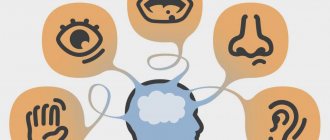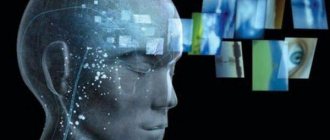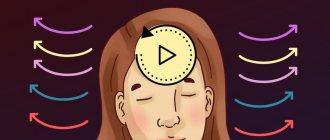Eidetism is the ability to accurately and maximally detailed reproduction of images (visual, sound, tactile) of individual objects or scenes after the cessation of their direct perception. These images are characterized by a difference from ordinary familiar themes, and the psyche continues to perceive the object in its actual absence. Another definition of eidetism characterizes it as the ability to independently evoke and hold in attention images that, in terms of the impact of their sensory characteristics, are identical or superior to reality. The phenomenon and the principles of its functioning have not been fully studied and are manifested only in a small percentage of the adult population, while in childhood eidetism is considered a more popular phenomenon. Subsequently, the functions of eidetic memory are lost or significantly weakened in the process of developing verbal skills.
Eidetism is a scientific definition in psychology, which in non-core literature and everyday use is called photographic memory. Photographic memory does not exist as one of the mnestic types. As a result of experiments aimed at establishing the fact of its existence as such, it was revealed that none of the group of subjects could fully fulfill the conditions of the experiment (reproduce from memory a text turned backwards, whereas when looking at a photograph this task is not particularly difficult ).
The presence of tendencies towards eidetism is due to physiological factors (genetics, brain development, neuroplasticity), but as a constitutional trait it persists in a relatively small number of adults. It was also noted that the preservation of eidetic abilities is associated with the nature of human activity, and is more common in creative professions.
The development of eidetism has several areas of training, during which, of course, mnestic abilities improve, but the eidetic type of memory does not always develop.
What it is?
The word "eidos" translated from Greek means "image". Eidetics is a technique for developing imaginative thinking. It is based on the ability of memory to retain and reproduce in small details the image of a certain object or phenomenon.
The development of memory, attention and imagination occurs through the involvement of all human analyzers.
Existing own internal experience contributes to the memorization of a new image depending on the visual, auditory or kinesthetic modality:
- visual modality is determined by memory associated with memorizing, preserving and reproducing visual images;
- the auditory modality is provided by auditory memory associated with the sounds stored in it;
- The kinesthetic modality stores and actualizes various movements, touches, smells, and taste sensations.
In psychology, the phenomenon of figurative memorization was first described in 1907 by the Serbian scientist Viktor Urbancic. Extensive research in this area was carried out in the German school of Eric Jensch in 1933. Representatives of the Marburg school came to the conclusion that eidetism is a natural phenomenon for preschoolers and primary schoolchildren.
The theory also interested Russian researchers. L. S. Vygotsky repeated the experiments of Eric Jaensch in his laboratory. Research was continued by Sergei Rubinstein, Boris Teplov, Fyodor Shemyakin, Alexander Luria and others. Since 1936, work on the study of eidetics was stopped in the USSR due to its recognition as a racist and unscientific theory.
Now many psychologists and teachers are showing scientific interest in the system for the development of a special type of figurative memory, attention and imagination. The basic principles of the method and the techniques used were described in detail in his works by Doctor of Pedagogical Sciences I. Yu. Matyugin.
Benefits and harms
Eidetics is of great benefit to children who are able to easily remember and develop their cognitive abilities using images. Instead of memorizing, they can quickly and efficiently absorb new material. It makes learning foreign languages easier, memorizing formulas, multi-digit numbers, and terms. The process occurs in the joyful and positive tension of the child.
Eidetics helps to harmoniously develop both hemispheres of the baby's brain . It promotes concentration, the development of non-standard thinking and imagination, strengthening imagination, and increasing performance. Eidetics guarantees easy memorization of any information, while psychological stereotypes are removed.
Failure to correctly evoke eidetic images can lead to serious consequences and cause significant harm. Psychology describes cases of nervous overstrain during persistent attempts to evoke the necessary image.
You need to competently reproduce it and be able to promptly get rid of the unnecessary image and mentally dissolve it.
Basic Concepts
Eidetics is interesting because in the absence of an object or phenomenon in the field of perception, a person feels it, smells it and sees color. In psychology, there are ideas about terms associated with this type of memorization.
Eidetism
The term means a type of figurative memory, expressed in the preservation of vivid images of previously perceived objects in their absence. The tendency towards eideticism can be determined by genetics or characteristics of brain development. Scientists are sure that everyone has the makings, but due to various circumstances, they are lost over the years. With age, it becomes difficult for most people to reproduce tactile, visual or sound images in detail.
Memory
Only 3% of the world's population is born with phenomenal memory. Other people have the opportunity to develop thinking and memory with the help of eidetics. The phenomenon is often called visual or photographic memory. Images are imprinted in memory for a long time and are played back at any moment like a video, with reproduction of the smallest details.
Image
A feature of eidetic images is the perception of objects in their absence. The stability and clarity of images stored in memory remains for a long time. Having ceased to be the main form of memory processes, they remain in the imagination and fantasy. At the same time, the basic psychological function changes.
Thinking
Synthesis, analysis, generalization, comparison when processing any information allow people with eidetic thinking to pay attention to small details and retain them in memory. In the future, they actively use the saved images.
Many outstanding mathematicians had this kind of thinking. In the modern world, it comes in handy when working with information technology.
Imagination
Vivid fantasy allows an individual to clearly imagine images that he has never seen. A person with an eidetic imagination can well imagine a breath of wind, smell some kind of aroma, feel coolness, or feel someone’s touch on his skin, as if this were happening in reality.
Degrees
The classification of the degrees of severity of the phenomenon was compiled jointly by the scientist E. Jaensch and his collaborators.
The division into groups occurs in 6 degrees, starting from the 0th to the 5th measure:
- During the stage, an afterimage (a continuation of what was seen) appears in memory after the disappearance of the object. The degree is characterized by short duration.
- Next, the object is visualized (giving the image clearer boundaries). Strong sensations of visual perception are added to the afterimage picture.
- Continued fixation of the image not only with the help of vision, but also with the influence of sound signals. Deviations in the size and shape of memorized objects are corrected.
- Memorizing visual images of non-complex objects. In this case, fixation is no longer required, complex objects are partially remembered.
- Bringing clarity and completeness to the visual image of complex objects.
- Complete visualization of complex images with all the small details.
According to the degree of severity of the phenomenon, a classification occurs of people who have the ability for logical representation, which are divided into 2 types:
- “T-type” represents people who have persistent and long-lasting imagery that does not require stimulation.
- “B-type” represents the type of people who have the ability to voluntarily awaken phenomena and consciously adjust images.
The question arises: what do images have to do with it?
The fact is that our memory depends on figurative and associative thinking. We cope with memorization on an intuitive level, but what happens to our imaginative thinking? With the help of figurative thinking, we are able to perceive information in the form of pictures. When we read an interesting book, images appear in our head automatically, and we easily reproduce and recall what we read.
How to make our memory remember what is necessary? And anyway, what does “remember” mean? We have heard this term since childhood: in kindergarten, at school, at home: “You must remember...” or “When will you finally remember?” etc. But no one says how to remember this.
Famous people with eidetic memory
History knows many examples of people with innate or acquired eidetic memory. Here are just a few of them:
- T. Roosevelt. Every day I trained my memory and read three books.
- N. Tesla. Since childhood, he had a phenomenal memory.
- John Paul II. Knew 21 languages and 100 dialects.
- Kim Peak. A simple, but at the same time unusual resident of America. Kim read two pages in parallel and immediately remembered what he read.
- Ferdinand Marcos. He memorized, reproduced or retold text of any complexity and volume.
- Julius Caesar. He had an excellent memory for faces and knew all the soldiers.
- Meryl Henner. Another ordinary, but unique American resident who remembered her entire childhood in detail.
- Mary Elizabeth Bowser. A legendary intelligence officer who memorized and accurately conveyed all the information she learned.
general information
What it is
Eidetics is a technique for developing memory, thinking and imagination through vivid images. It allows you to actively remember and quickly reproduce any details. But most importantly, it is recognized as one of the leading areas that contribute to the formation of extraordinary thinking. You can contact her at any age. Of course, those who regularly exercise from an early age will achieve greater results . But, as practice shows, it is also useful for adults.
From the history
Increased interest in eidetics has arisen in the last decade. Many people think that this is an innovative technique developed by scientists of the 21st century. In fact, this is a misconception.
Even in Ancient Greece, an eidetic person, possessing an ideal visual (eidetic) memory, attracted the attention of scientists, philosophers and thinkers of that time. Even then they were thinking about how it could be developed as much as possible. There are even simple exercises in ancient manuscripts - they laid the foundation for eidetics.
A surge of interest in this doctrine was observed at the beginning of the twentieth century in Western Europe. The first detailed descriptions are contained in the works of the Serbian scientist Viktor Urbancic (1907). His ideas were picked up by the German psychologist and philosopher Eric Jaensch (20s). The Marburg school of psychology, founded by Jensch, made a great contribution to the development of eidetics. In Russia, its theory and practice were studied by P. P. Blonsky, A. R. Luria, L. S. Vygotsky. However, after World War II the wave began to decline.
Today in Russia it is inextricably linked with the name of I. Yu. Matyugin, Doctor of Pedagogical Sciences. In his works, he substantiated the basic principles of the method, described in detail its tools and techniques used. Thanks to him, Eidetics Schools are opening all over the country, offering classes to people of all ages.
Basic Concepts
You should understand the difference between the concepts of “eidetics” and “eidetism”.
Eidetism is the ability to remember the smallest details of what is seen, often accompanied by additional images - visual, gustatory, auditory, olfactory, motor, tactile. For example, the famous Russian composer Nikolai Rachmaninov could only look at the notes once and play the piece of music written in them from beginning to end. Many celebrities have had this gift.
Eidetic memory is also called visual or photographic memory. It can be congenital or acquired, that is, consciously developed during life. In the first case, people who have this ability are perceived by others as phenomena. But in psychology this is a common type of memory - along with sensory, spatial and social. And psychotherapists claim that this is a pathology, since people with such a supernatural ability often suffer from hallucinations, epilepsy and other severe mental disorders.
An eidetic image (EO) is a subjective representation of an object some time after direct contact with it. It is distinguished by clarity, detail, stability (retained in memory for a long time). Most often it is visual or acoustic. It is its formation that occurs during eidetic classes.
Eidetic thinking (EM) is the ability, when processing information of any kind (synthesis, analysis, generalization, comparison), to pay attention to the smallest details and store them in memory for further active use. Outstanding mathematicians, for whom every number is important, try to develop EM throughout their lives. And eidetics helps them in this.
Eidetic imagination (EI) is a vivid fantasy that allows a person to imagine everything in his mind in detail, although in reality this has never happened. Moreover, these images are so clear that a kind of déjà vu arises. Smells are felt, the wind blows, voices are heard saying something with different intonations, the skin feels coolness or touch, as if it were in reality.
Eidetics successfully contributes to the development of all these mental categories. If you do it for a long time and seriously, the result will be eidetic perception, which completely transforms a person’s life. He begins to become aware of the world around him in the form of vivid, memorable images. This simplifies everyday tasks, promotes quick response even to the most unexpected situations, and helps you be successful in various areas.
Origin. The term “eidetics” goes back to the ancient Greek word “εἶδος”, which is translated as “image, appearance, appearance”.
Development
Photographic memory can be innate or acquired. In the first case, this is due to abnormalities in brain development. In the second case, this is due to targeted work. Eidetics is the name of the science of the development of eidetic memory. Psychologists identify several approaches to the development of eidetic memory.
According to Aivazovsky's method:
- Select an item, thing or object. Living or inanimate, the main thing is not abstract.
- For a couple of minutes, carefully study the object, delve into every little detail, observe it.
- Close your eyes, try to abstract yourself from the outside world and noise. Imagine this image in front of you. Repeat the details that you noticed, mentally draw them in front of you.
- Open your eyes and compare the real object and the one you reproduced. Are there significant differences?
- Repeat the exercise until you can visualize the object as accurately as possible.
- Gradually make the task more difficult for yourself, for example, reduce the time spent studying the object.
Neurobics (aerobics for the brain):
- Change your route regularly to your usual place. For example, before work or a cafe where you regularly have lunch. Try to carefully study the routes and remember them.
- Do familiar things with your left hand (if you are left-handed, with your right). For example, try holding a toothbrush, spoon, or pen in your left hand.
- Watch TV without sound. Try to understand what is being said by the general atmosphere, setting, gestures and movements.
Eidetics helps not only in the development of photographic memory, but also in strengthening memory as such. And also with the help of training you can prevent the occurrence of Alzheimer's disease, senile dementia and similar pathologies.
Interesting! Congenital eidetism is often associated with autism, schizophrenia, epilepsy, mental retardation and other mental disorders.
Benefit
The main task of eidetics is the development of memory and attention. However, its benefits for personal improvement are not limited to this. It can have a much more multifaceted impact:
- develops figurative memory;
- sharpens concentration;
- enhances the ability of imagination;
- allows you to remember much faster and more information than with mechanical “cramming”;
- facilitates the learning of foreign languages;
- makes it easier to memorize illogical formulas, unpronounceable terms, and multi-digit numbers;
- develops figurative and associative thinking;
- removes psychological stereotypes when memorizing information;
- increases performance.
Eidetics achieves all this by actively using bright, often unexpected images and emotional components when memorizing material. Thus, the process becomes interesting, motivated and significantly simplified.
That is why the eidetic method of memory development is now being so actively introduced into kindergartens and schools. Educators, teachers and parents know very well how difficult it is to interest a little fidget in studying and learn something with him. There is not enough gaming activity for a long time. If you use visual images in combination with it, things will go easier and much faster.
The eidetics method becomes even more useful in high school and college, when you have to learn a huge amount of material. If you skillfully use visual and emotional images, this will cease to be a problem and will significantly facilitate preparation for exams.
Methods
The main tools of eidetics are associations and acroverbal technique.
Working with associations
It is carried out in two directions: the chain method and the method of visual associations.
Chain method
The bottom line: you can connect even the most distant objects with each other using logical chains.
Exercise: 10-15 completely different words are selected (absolutely any: button, fast food, government, law, cactus, grandfather, finger, pleasure, literacy, tape). Assignment: compose them into a coherent story or just a logical chain. Sample text: The government has issued a law to get the maximum pleasure from fast food, for which they will issue certificates with cacti. Grandfather was so happy about this that he cut his finger and had to wrap it with tape.
According to eidetics, the more awkward the logical chain is, the brighter the eidetic images will be. It’s easy to forget the gray bunny and the yellow sun, because they are typical and everyday. But a letter with a cactus, a law on fast food, a grandfather with a finger wrapped in tape - this is fresh and unusual. The result is that all 10 words will remain in memory.
Visual associations
The essence: linking the information that needs to be remembered to a specific place, person, situation. A kind of “anchoring” from NLP.
Application in practice. For example, when explaining topics in the Russian language “Etymology” or “Similar words”. The teacher shows the class a spindle and a clock and asks them to find something in common between them. Naturally, these are two completely different subjects that are in no way related to each other. But it turns out that the spindle is spinning like the hands on a clock. Therefore, historically the words spindle, spin and time are closely related and have the same root. In the future, the student will only need to remember these two things in order to reproduce this information.
Acroverbal method
Memory training using eidetics is rarely possible without it, although it is actively used by mnemonics, neurobics, NLP and other areas.
The bottom line: to make it easier to memorize educational material, it is “encrypted” into poems, various abbreviations, codes, songs and even jokes. Firstly, it turns out clearly. Secondly, it is fascinating and educational. Thirdly, it is easy to remember. The student easily learns two lines of a funny rhyme, which at the right moment evokes the necessary images and associations in his subconscious. And instead of rhyming, he tells the rule in the Russian language.
Techniques used:
- rhyme (“something, either, that, something - don’t forget to put a hyphen”);
- phrases from the first letters of the material (the colors of the rainbow in the famous saying about the hunter with a pheasant);
- connective (when studying the Pythagorean theorem, imagine in all its colors how he ran around his triangle and made a discovery);
- hook (for example, replacing numbers with objects);
- Cicero's method.
Acrostic poem for memorizing the colors of the rainbow
Eidetics has in its arsenal many other techniques for developing ideal visual memory, figurative-associative thinking and increasing concentration:
- casual observation;
- textual criticism;
- palindromes;
- gymnastics for the brain (neurobics).
By regularly practicing eidetics, you can well develop the ability to quickly and without coercion remember the maximum amount of a wide variety of information.
Eidetics for children
Eidetics acquires particular significance in classes with children. Their psyche and cognitive abilities are like plasticine. If you work on the development of visual memory and figurative-associative thinking, starting from an early age (for example, regularly organizing such classes for preschoolers), this will bring excellent results.
Such children quickly change their leading activity from play to learning and are actively involved in the school learning process. They rarely have problems learning material. This allows them to be successful in their studies and realize their creativity (under the influence of a well-formed eidetic imagination).
Lesson program (as an example)
An exemplary educational program for teachers of preschool educational institutions and primary school teachers and “Development of children’s memory using eidetic methods.”
Exercises
Eidetics exercises can be included in their classes by kindergarten teachers, primary school teachers and psychologists working with young children. They are also a must-have for parents who want to comprehensively develop their child.
Basic exercises on eidetics for preschool children will help you understand how to properly organize a lesson and conduct further work in this direction.
Visual drawing
The technique is used in the study of numbers. Children are given sheets of paper with three-dimensional contours of the number being studied. They should see in it the figure of some animal, person, thing and complete the drawing. For example, zero is a mirror, eight is a tumbler doll, three is a snake, etc. In the future, when playing a number, they will remember exactly this image and quickly name what the teacher requires.
Mental drawing
When memorizing a poem, it is necessary for the child to imagine as much as possible what is described in it. You can recreate the sounds of the forest or the sound of the surf, splash droplets of water on your skin, or turn on slides on the projector with the necessary illustrations. Give the task to describe in detail what he feels, perceives, thinks. Such recitation will consolidate eidetic images in memory.
Eidetics is a unique modern technique for developing attention, memory and a special type of thinking. It shows excellent results and allows you to work not only with children. This is a great opportunity to improve yourself so as not to stand still and constantly achieve new heights.
How to prepare your brain?
The brain, like any other part of the human body, needs a balanced diet, sufficient rest, and moderate physical activity. By normalizing your lifestyle and maintaining it at the same level, you can significantly increase your mental abilities and improve your memory.
Dream
Healthy sleep helps brain activity reboot. In this way, the body “sorts out” all the information it receives during the day, and gets rid of unnecessary information.
During sleep, nerve fibers sort through memories, analyze what is important and what is not. Next, the brain stores the information received in certain areas of memory. This process is called consolidation.
Scientists recommend monitoring the quantity and quality of sleep. The normal duration of rest hours should be 7-8 hours.
Nutrition
The functioning of the nervous system is greatly influenced by proper nutrition. It is normal when the diet includes a sufficient amount of vitamins, fiber, proteins and healthy fatty acids.
It should be borne in mind that flavor enhancers and preservatives reduce mental performance, as well as red meat and alcohol, so it is recommended to include more natural foods in the menu. The Mediterranean diet is especially beneficial in summer.
The diet must include:
- fresh fruits;
- dairy products;
- whole grain dishes;
- pasta;
- leguminous plants;
- nuts, seeds;
- vegetable oil;
- fish;
- bird.
Physical exercise
The physiological side of the issue implies not only the presence of proper nutrition and a rational regime of wakefulness and sleep, but also moderate physical activity in the form of:
- morning exercises;
- walking in the fresh air;
- running;
- dancing.
Research has shown that regular physical activity improves cognitive function. During exercise, a substance is produced in the brain that promotes the restoration of neurons and the reconstruction of connections between them.











